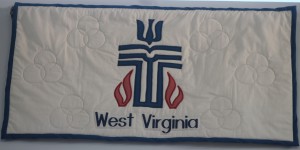By Ed Thompson and Mike Givler
 As is the case with many of the western presbyteries within the Synod of the Trinity, the Presbytery of West Virginia’s roots stem from the Presbytery of Redstone, which encompassed much of what eventually became the state of West Virginia (and beyond) when it was created in 1781. A few years later in 1789, the first General Assembly created a new configuration of synods with the Synod of Virginia composed of the presbyteries of Redstone, Hanover, Lexington and Transylvania.
As is the case with many of the western presbyteries within the Synod of the Trinity, the Presbytery of West Virginia’s roots stem from the Presbytery of Redstone, which encompassed much of what eventually became the state of West Virginia (and beyond) when it was created in 1781. A few years later in 1789, the first General Assembly created a new configuration of synods with the Synod of Virginia composed of the presbyteries of Redstone, Hanover, Lexington and Transylvania.
By 1802, the Synod of Virginia included more territory to the south and west and less to the north as Redstone Presbytery moved into the Synod of Pittsburgh.
The Civil War probably had more effect on West Virginia than most of the nation. It basically split the church. The churches in the Synod of Virginia became a part of the Presbyterian Church in the Confederate States of America while the churches in the Synod of Pittsburgh remained with the Presbyterian Church U.S.A. On June 20, 1863, West Virginia was admitted into the Union. In that same year the General Assembly formed the Presbytery of West Virginia in the northern part of the state as part of the Synod of Wheeling.
After the Civil War the Presbyterian Church in the Confederate States of America became known as the Presbyterian Church in the United States. Greenbrier Presbytery, which had been formed from Lexington Presbytery in 1837, was divided again in 1895 to form the Presbytery of Kanawha. Further divisions resulted in the presbyteries of Bluestone, Guyandotte and Tygarts Valley. In 1914 these presbyteries split off from the Synod of Virginia to become the Synod of West Virginia.
The presbyteries in the Presbyterian Church U.S.A. had taken a similar step in 1902 when the General Assembly created the Presbytery of Wheeling and then formed a Synod of West Virginia, which included that presbytery as well as the presbyteries of Grafton and Parkersburg. It remained the Synod of West Virginia until 1973 when General Assembly created regional judicatories and merged it with the Synod of Pennsylvania to form the Synod of Pennsylvania-West Virginia.
In 1974 the presbyteries in West Virginia in the Presbyterian Church in the United States were merged to form the Presbytery of Greenbrier, which then became part of the Synod of the Virginias.
After the United Presbyterian Church in the U.S.A. and the Presbyterian Church in the United States joined to heal the division caused by the Civil War, the Presbytery of West Virginia was formed in 1987 to bring together Greenbrier, Grafton and Parkersburg Presbyteries.
Several West Virginia colleges have strong ties to the Presbyterian denomination including Davis & Elkins College, which was started in 1901 by U.S. Senators Henry Davis and his son-in-law Stephen Elkins, who donated land and money to help establish the school.
The Presbytery of West Virginia also supports the West Virginia Ministry of Advocacy & Workcamps, a long-term recovery response arm formed in 2002 after severe flooding in the state.
The Presbytery of West Virginia currently oversees churches in 44 of the 55 counties in the state of West Virginia and one church in Ohio. The presbytery now has 132 congregations, half of which have 30 members or less.
